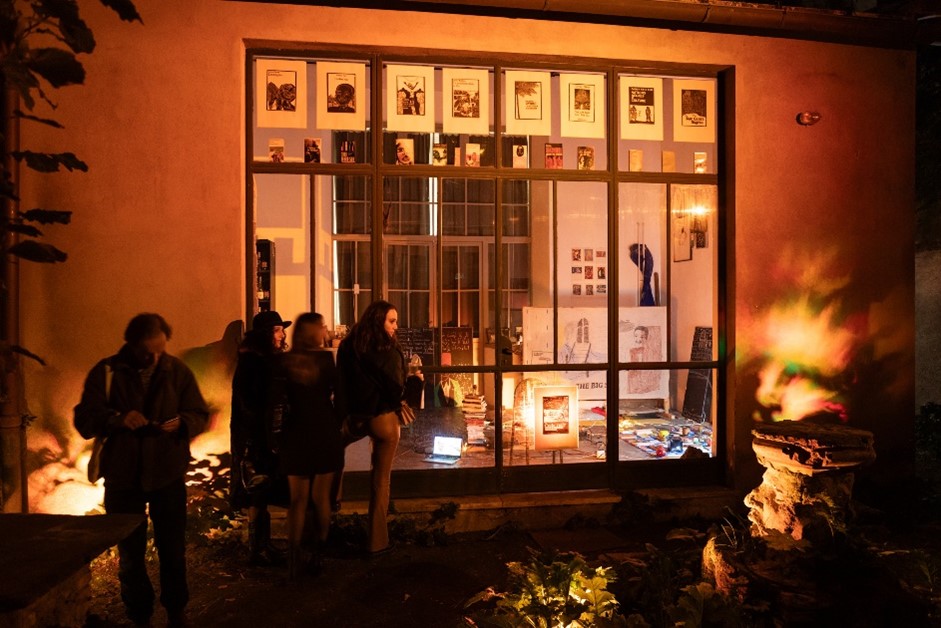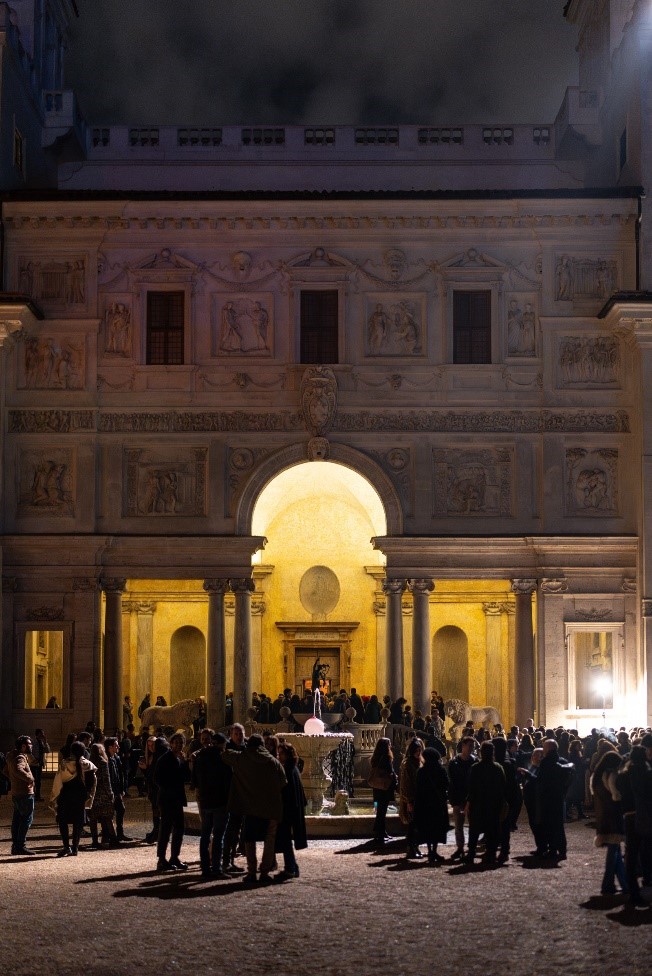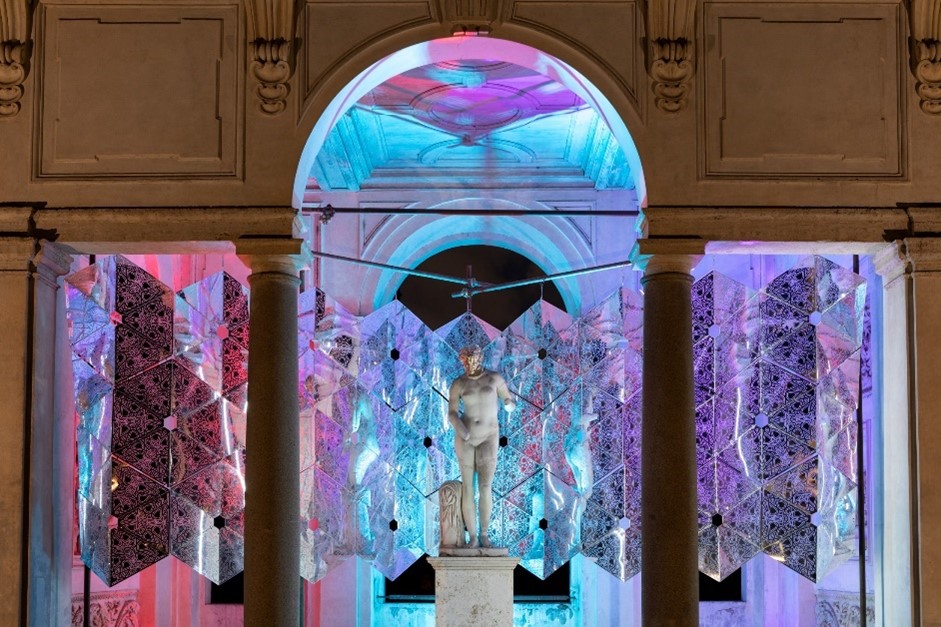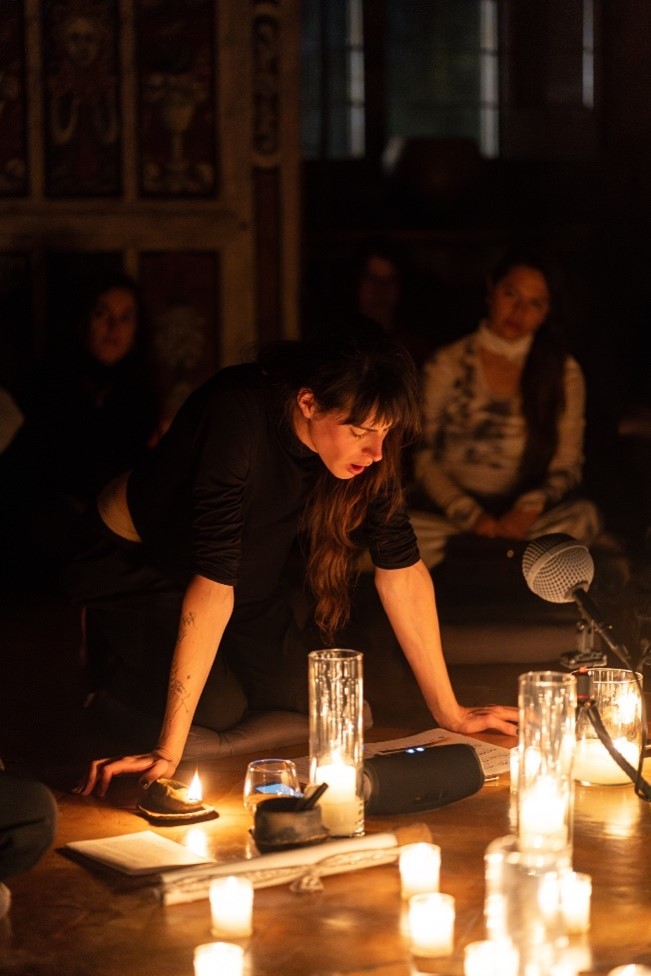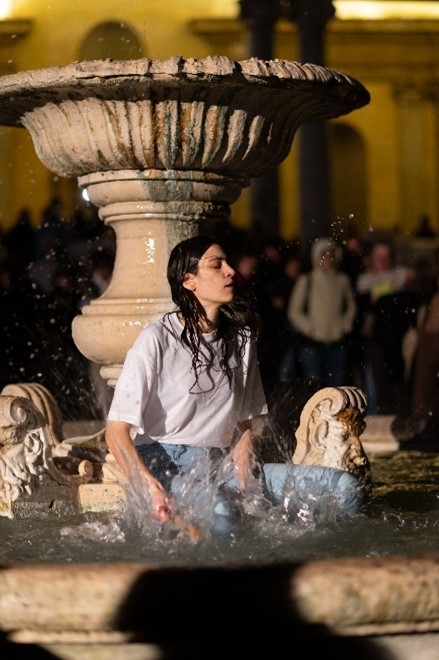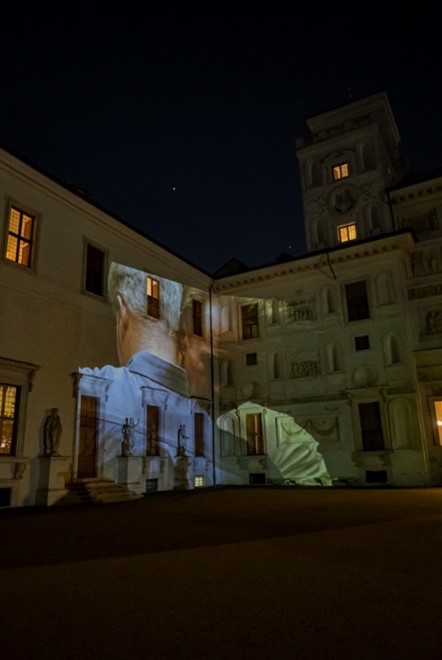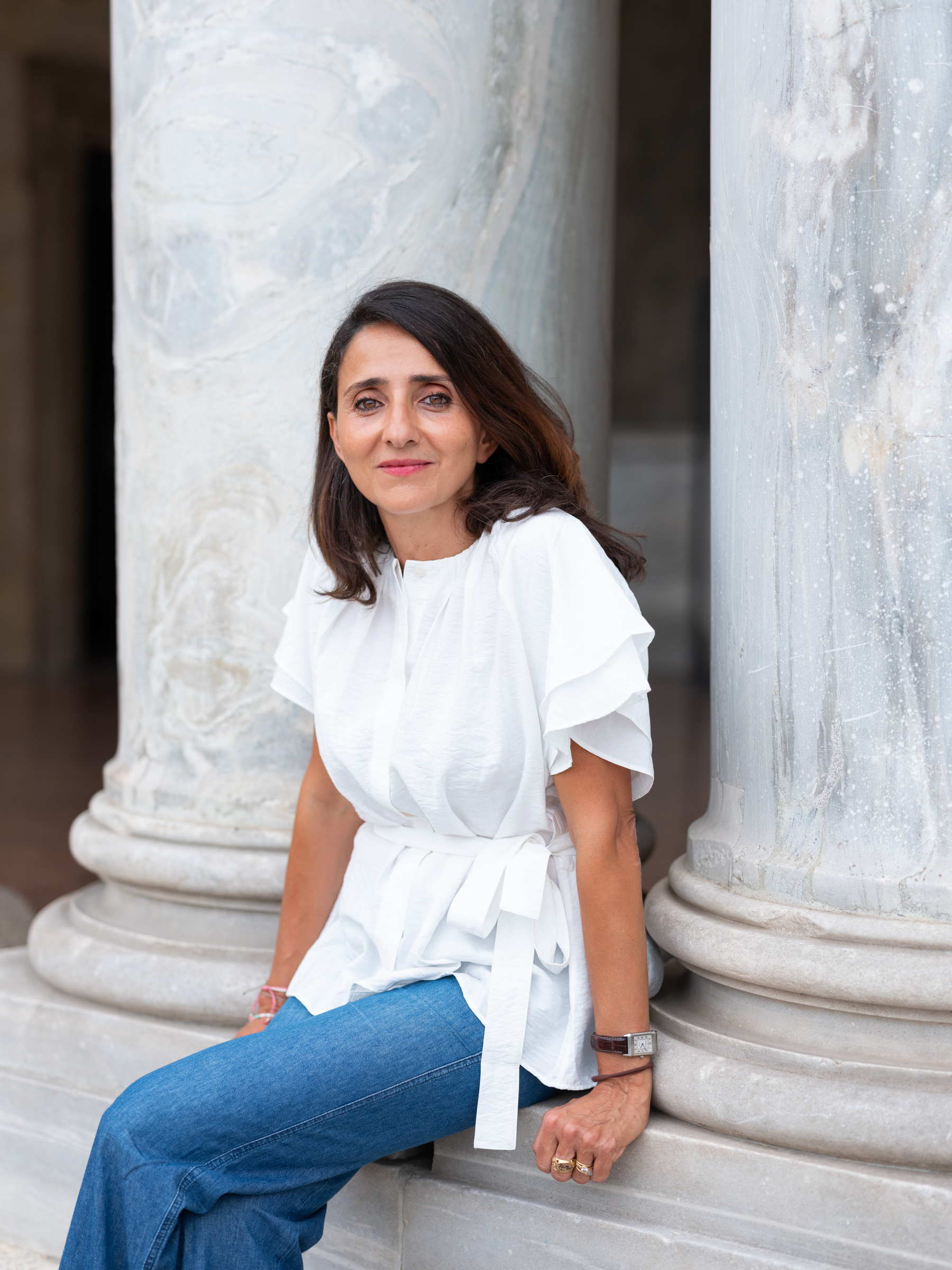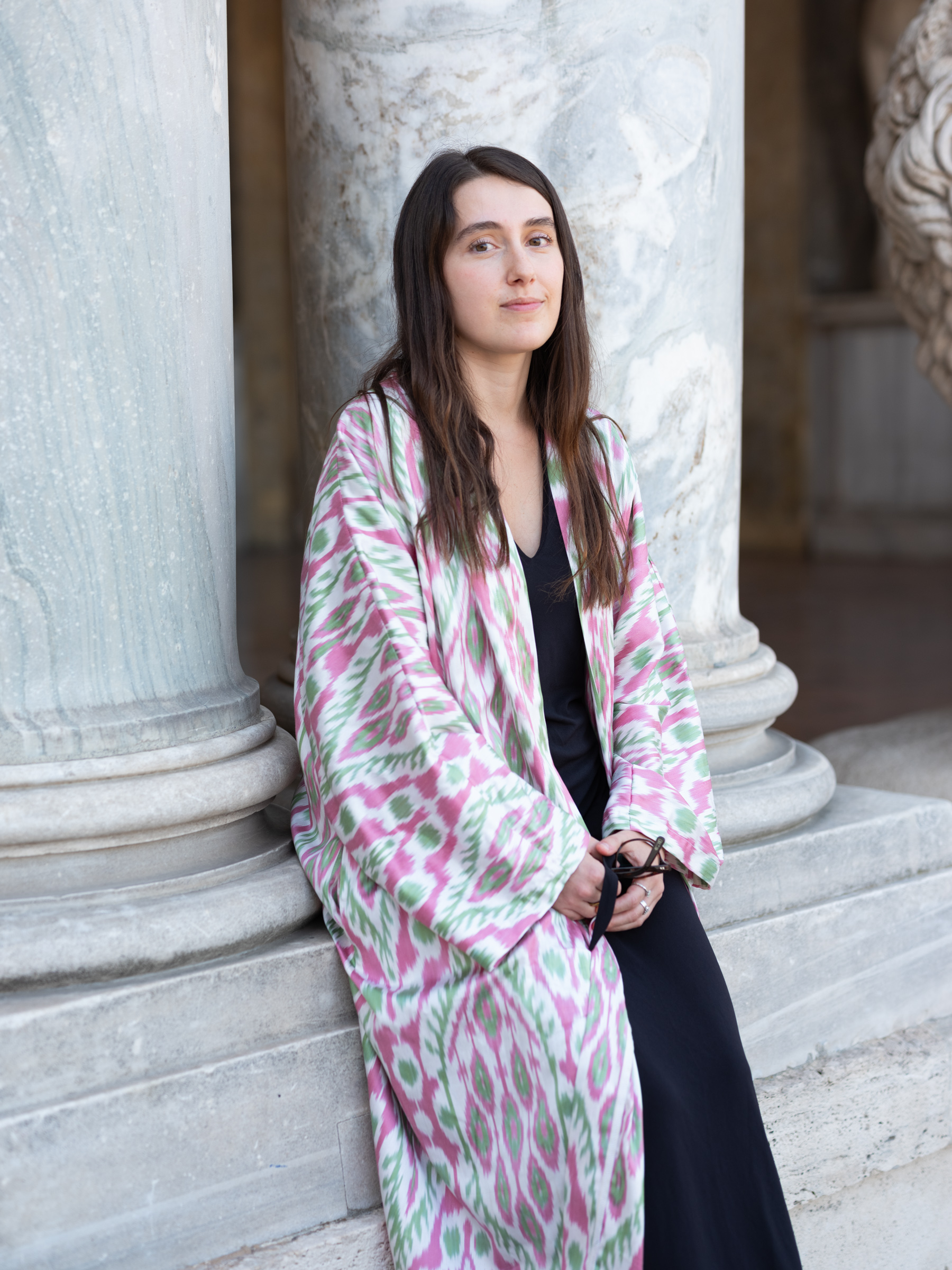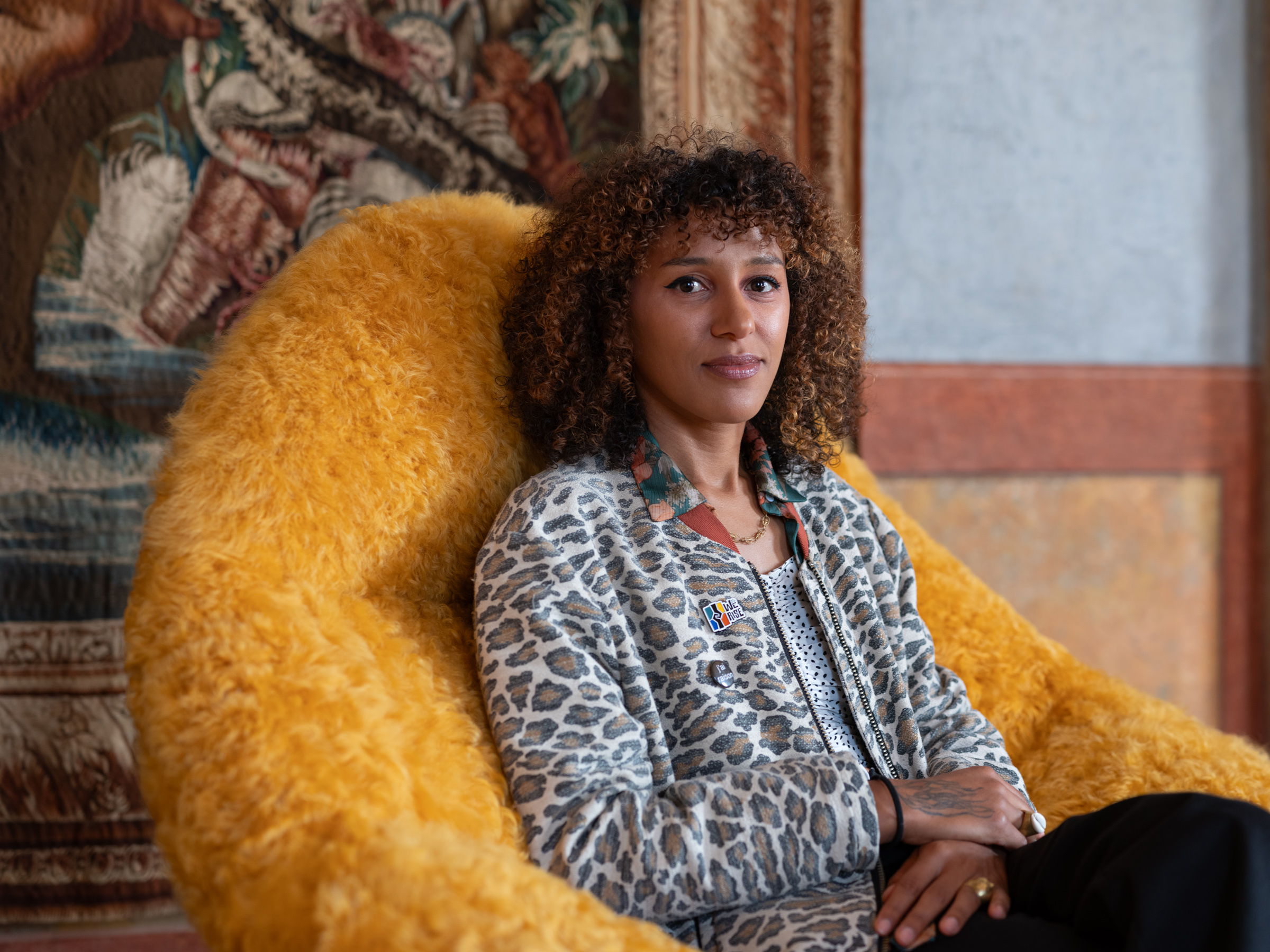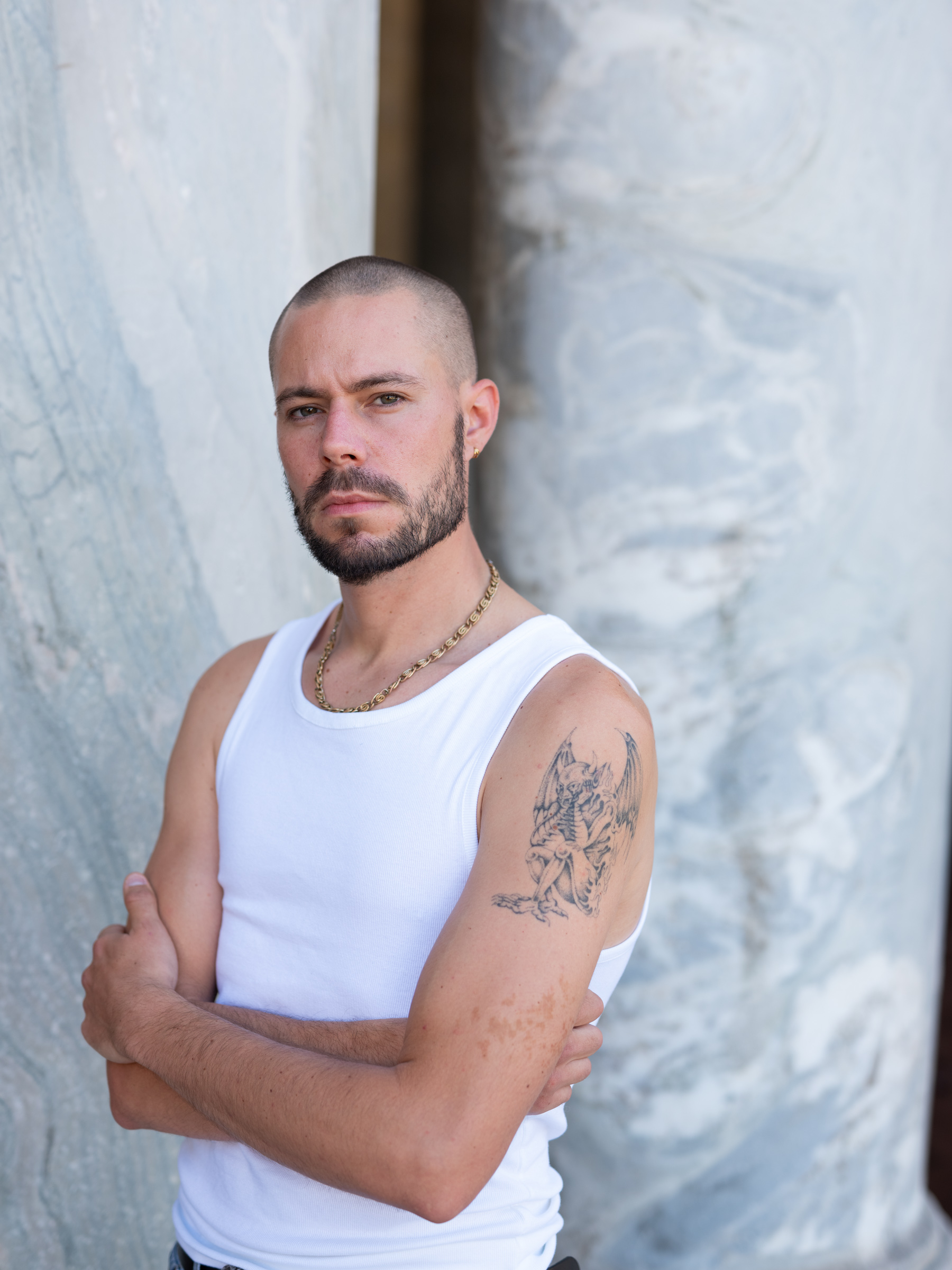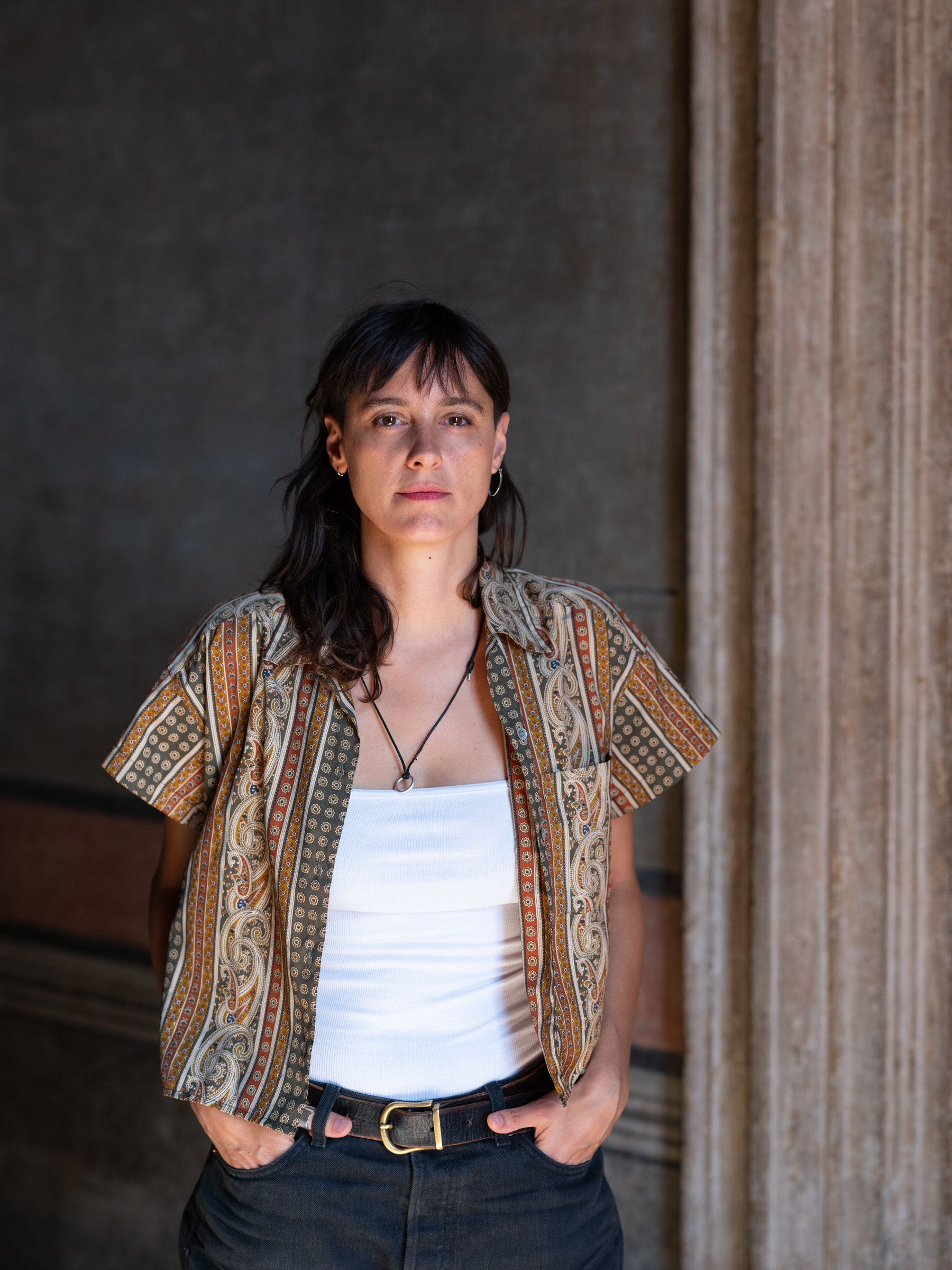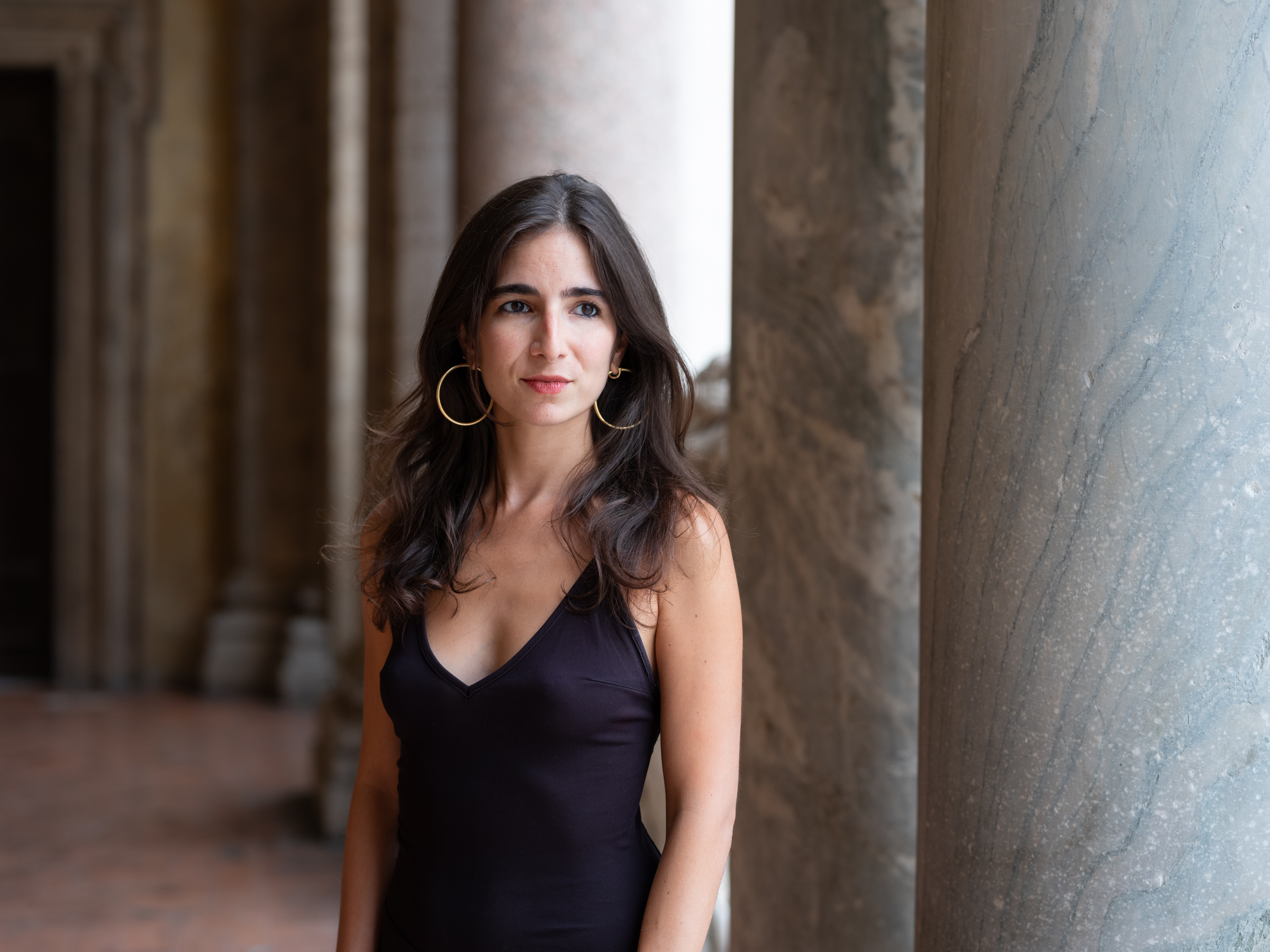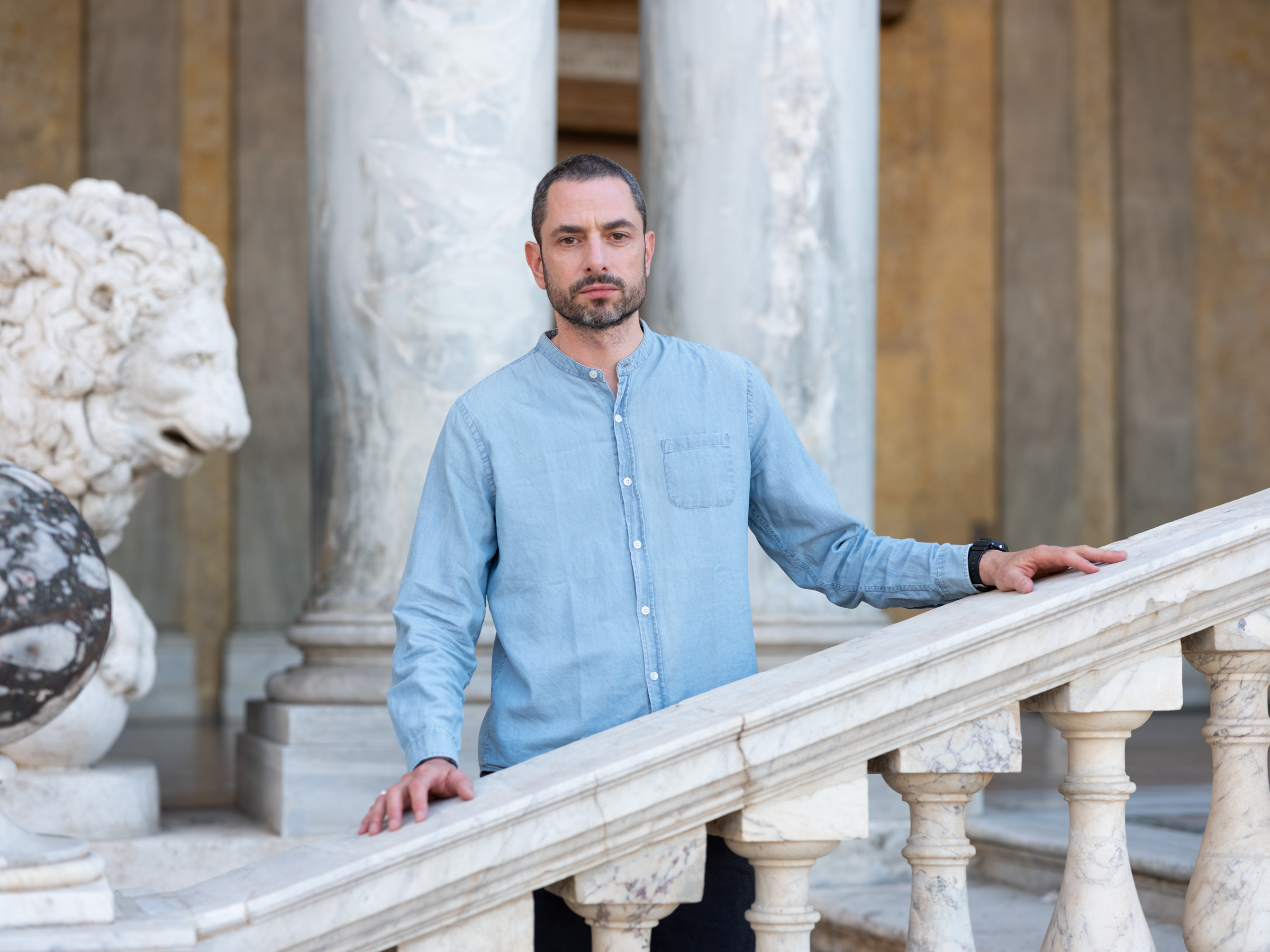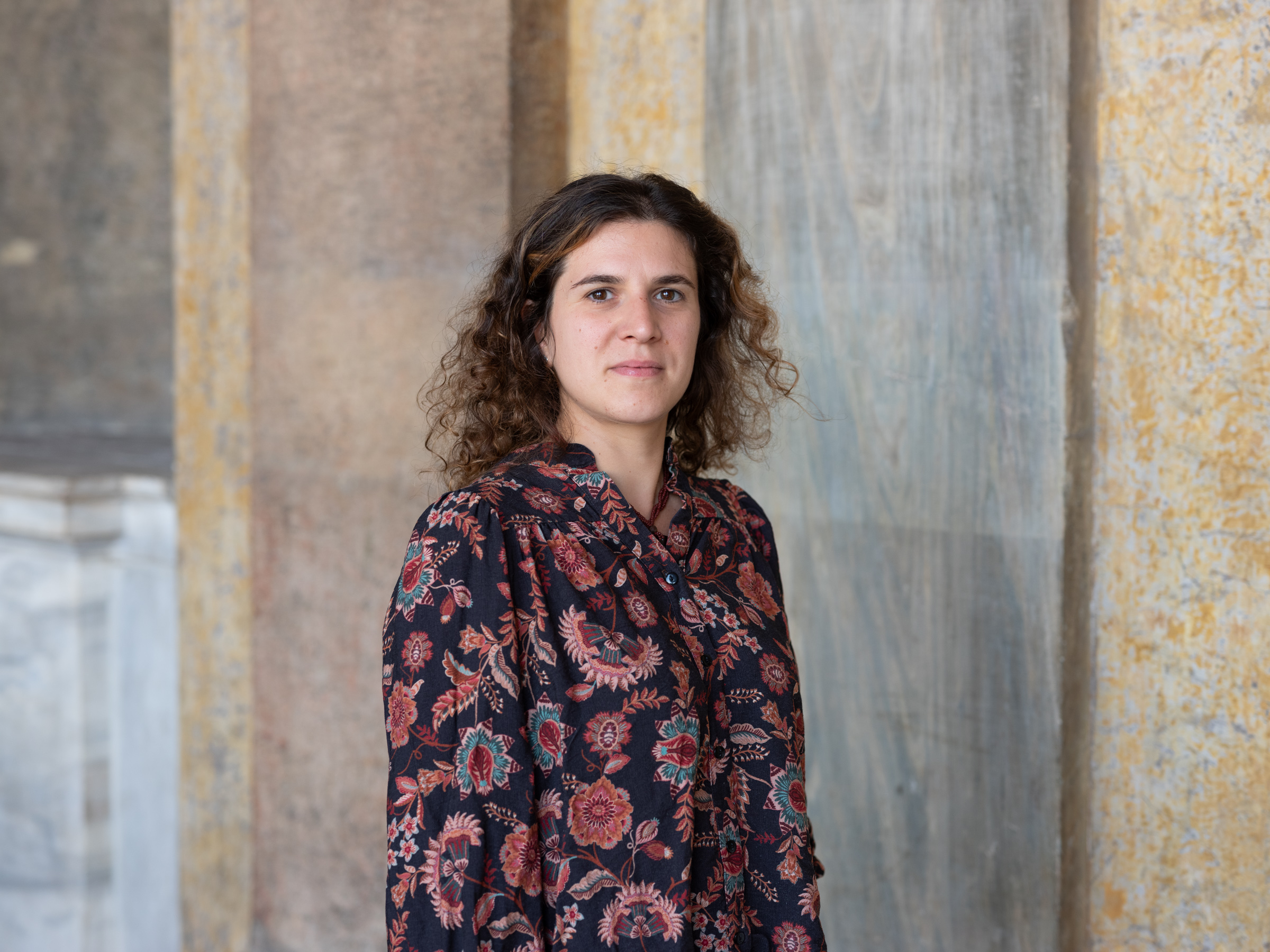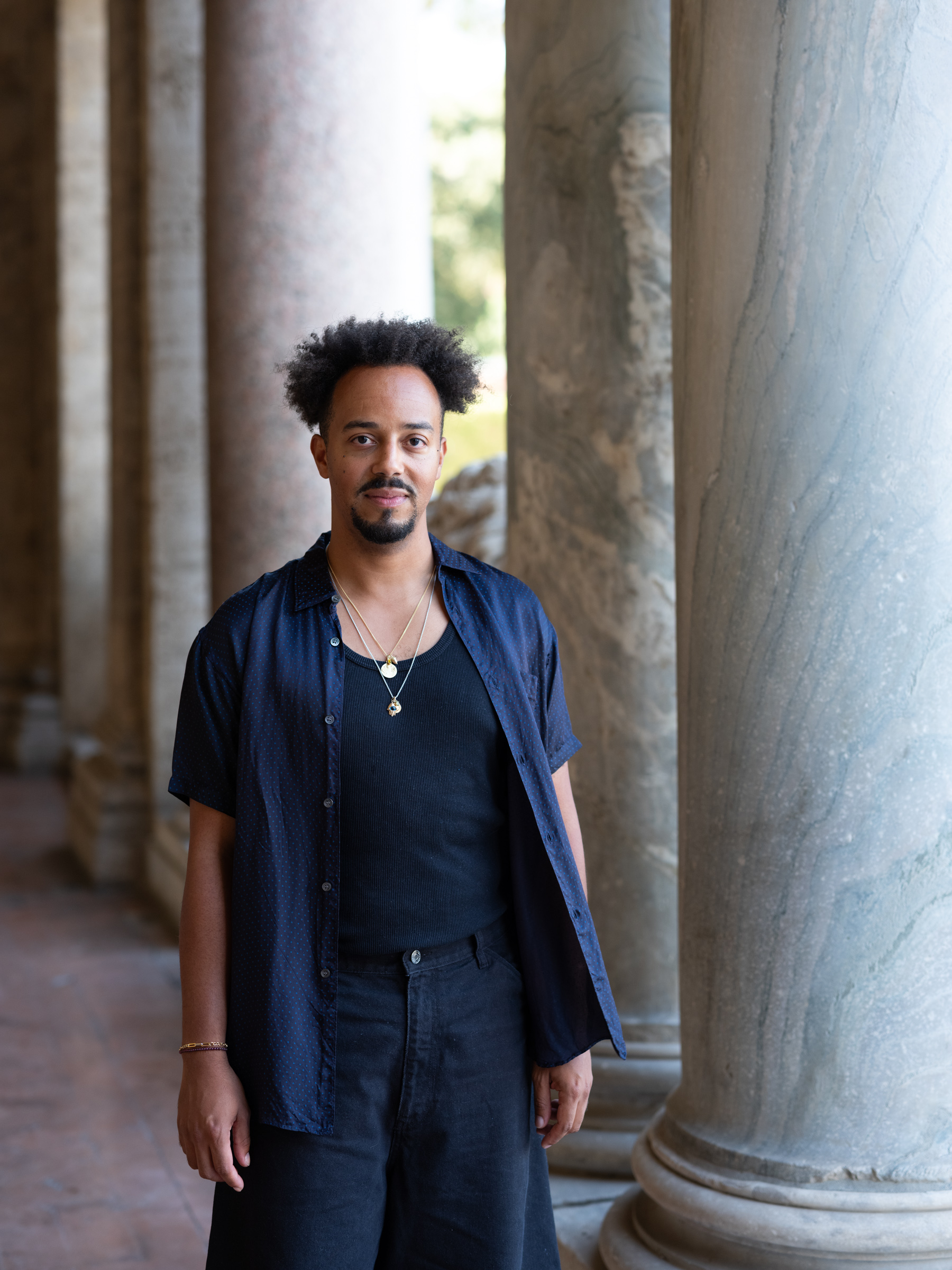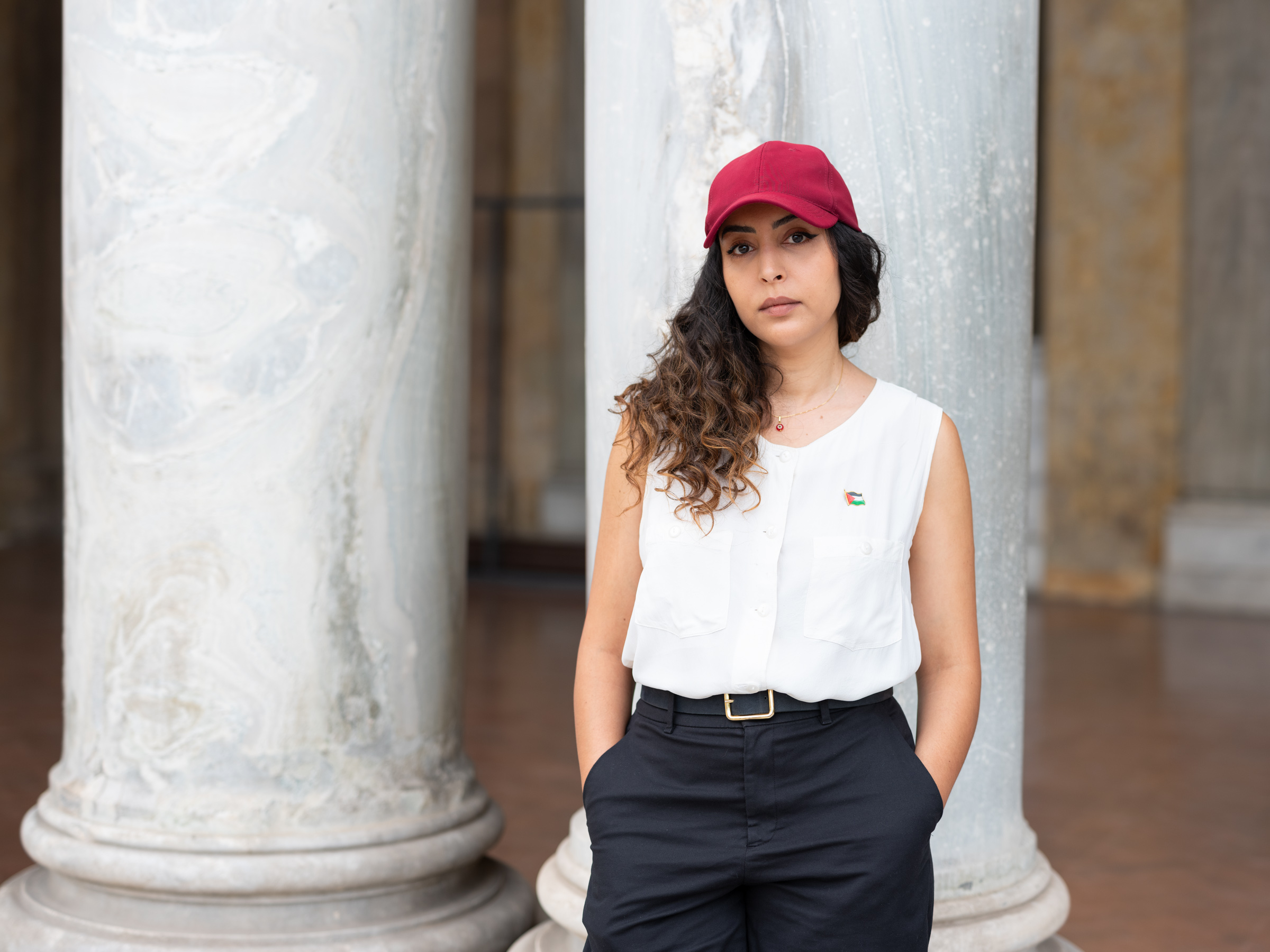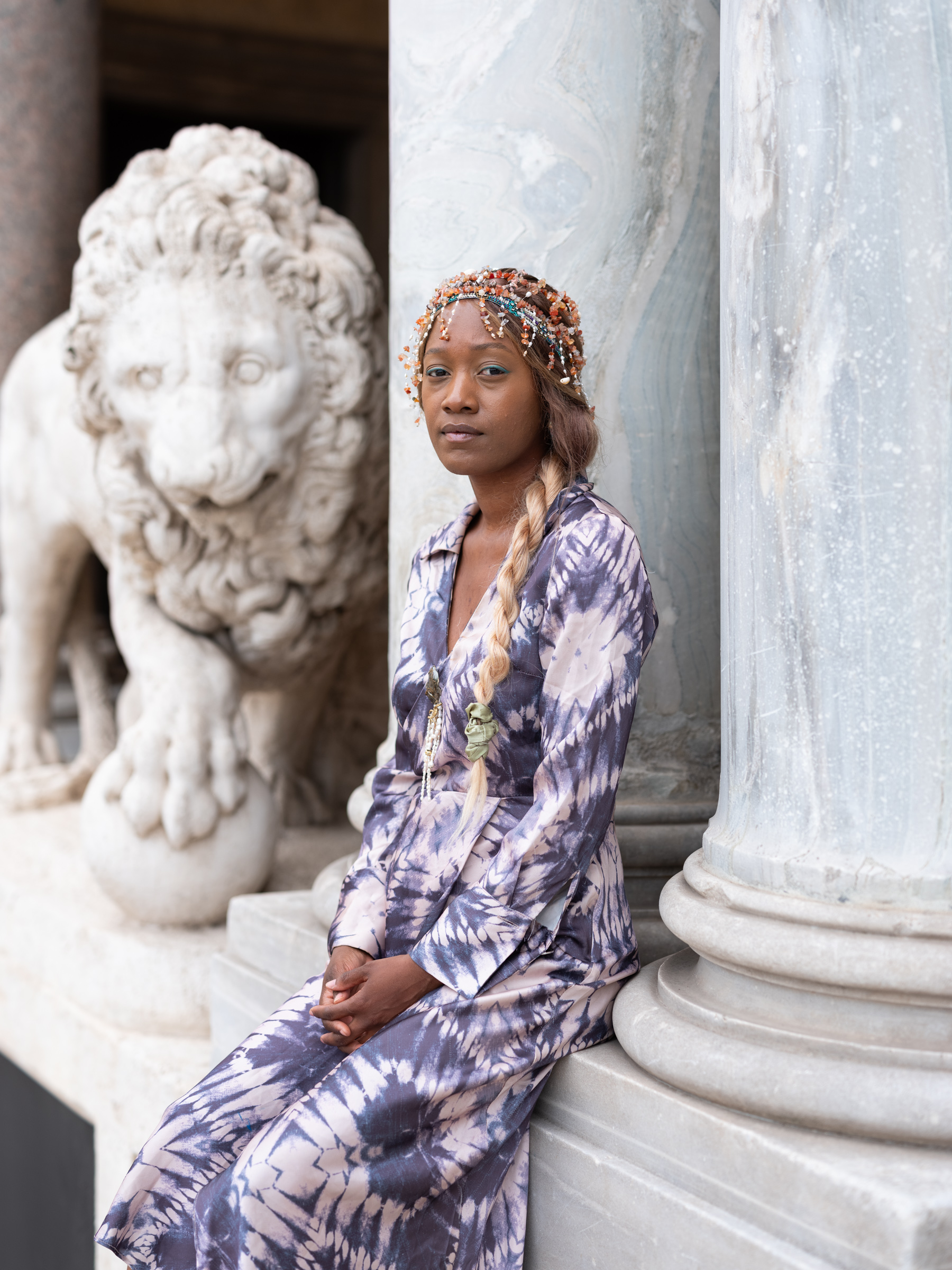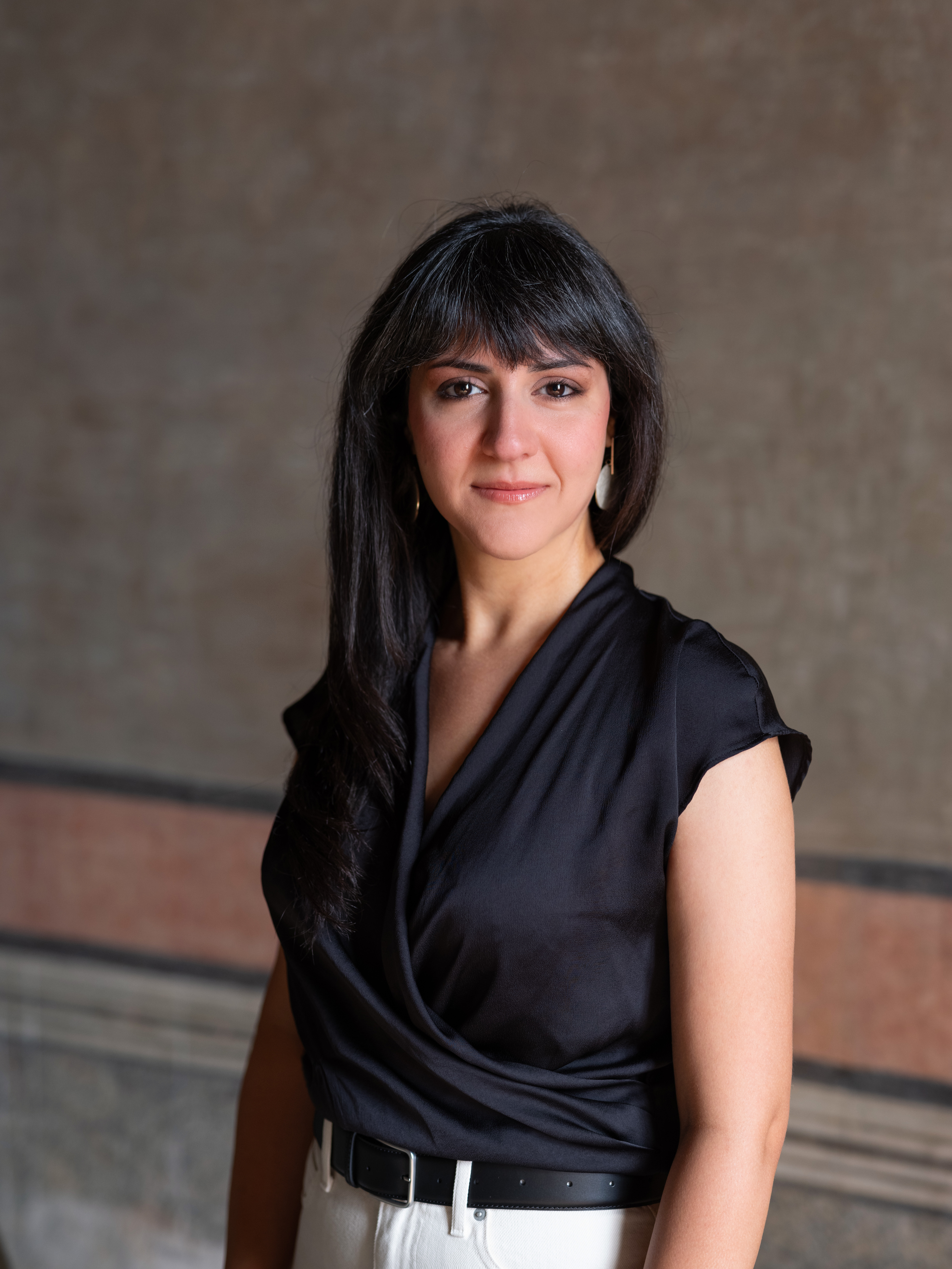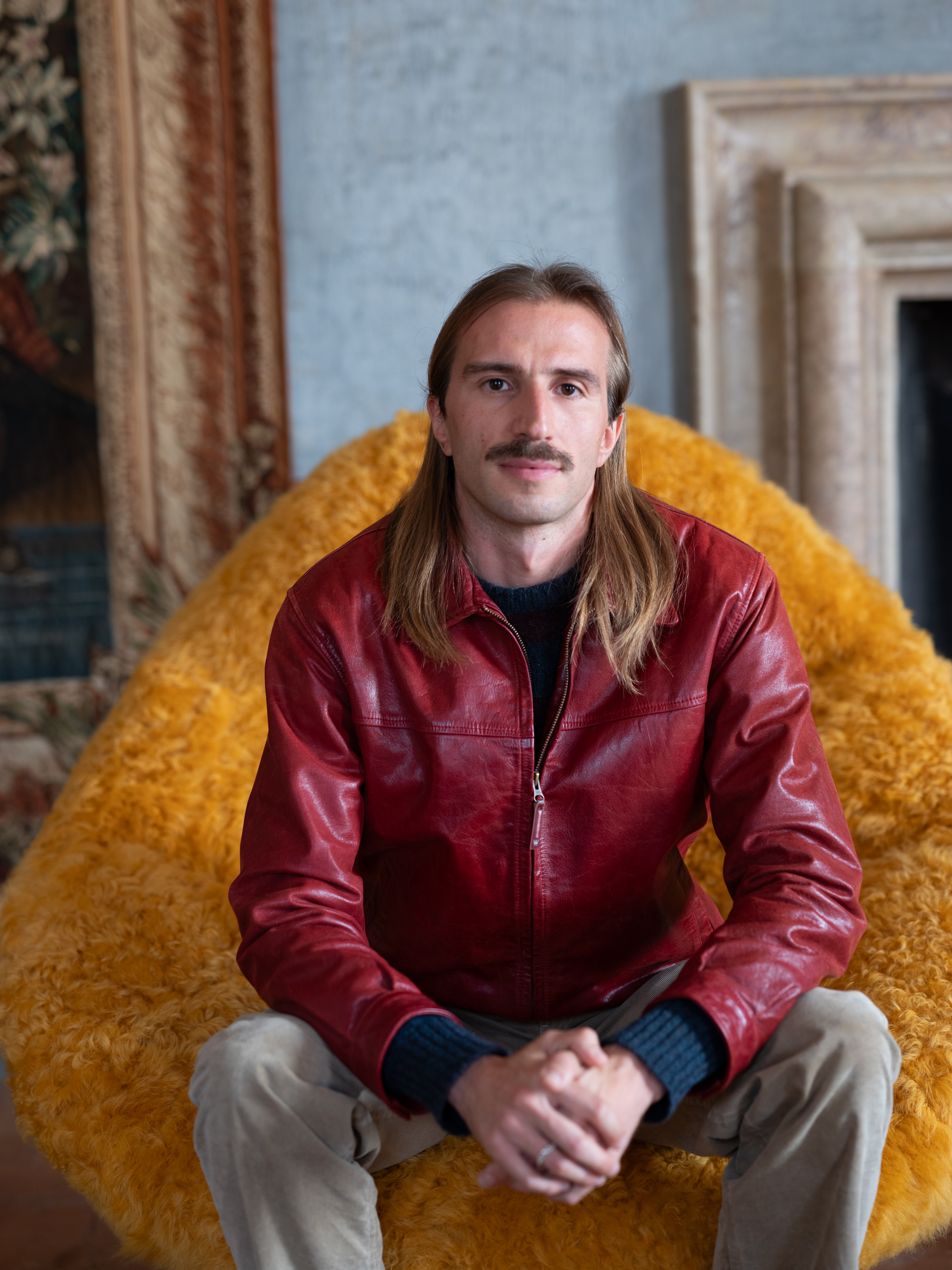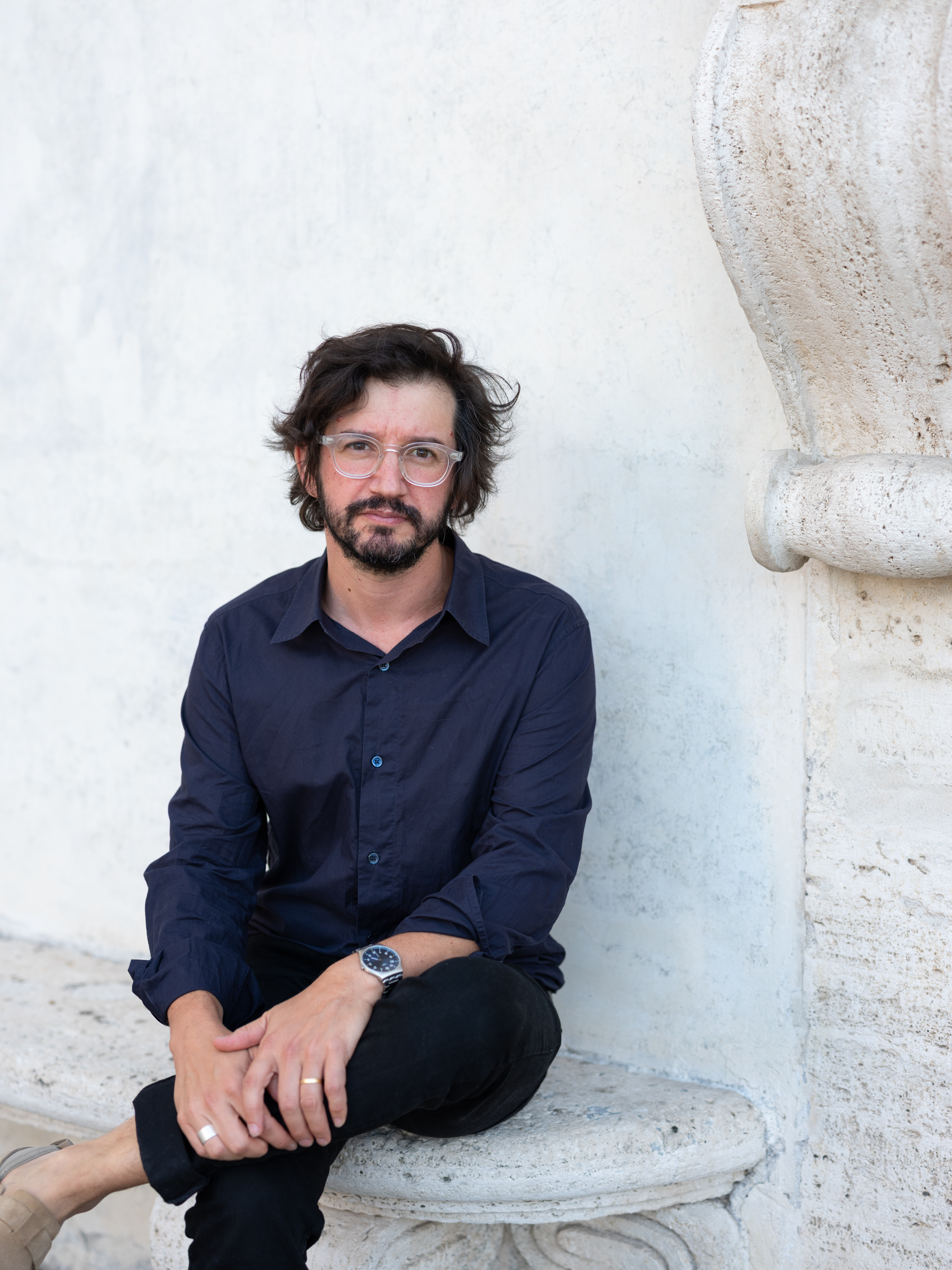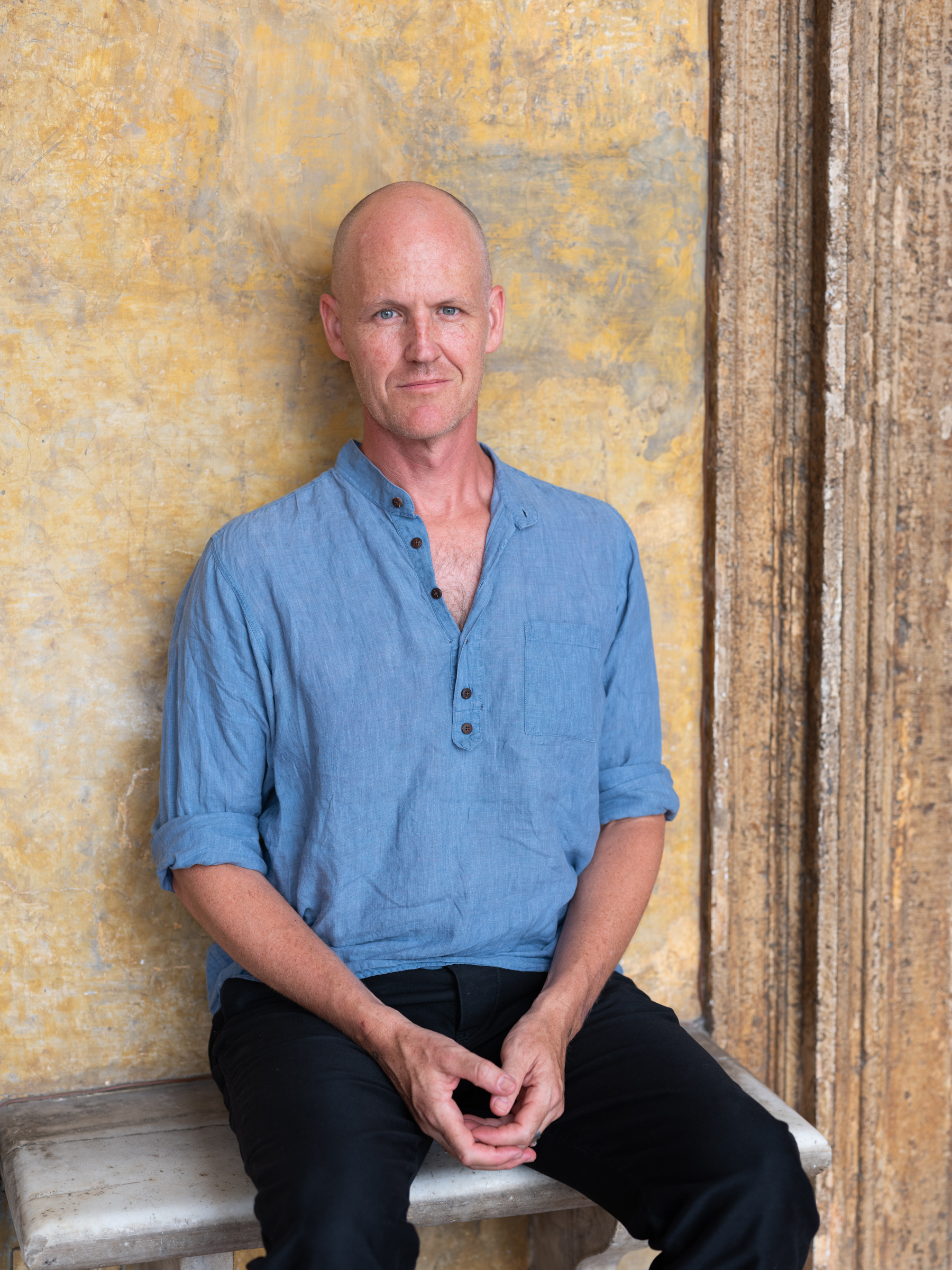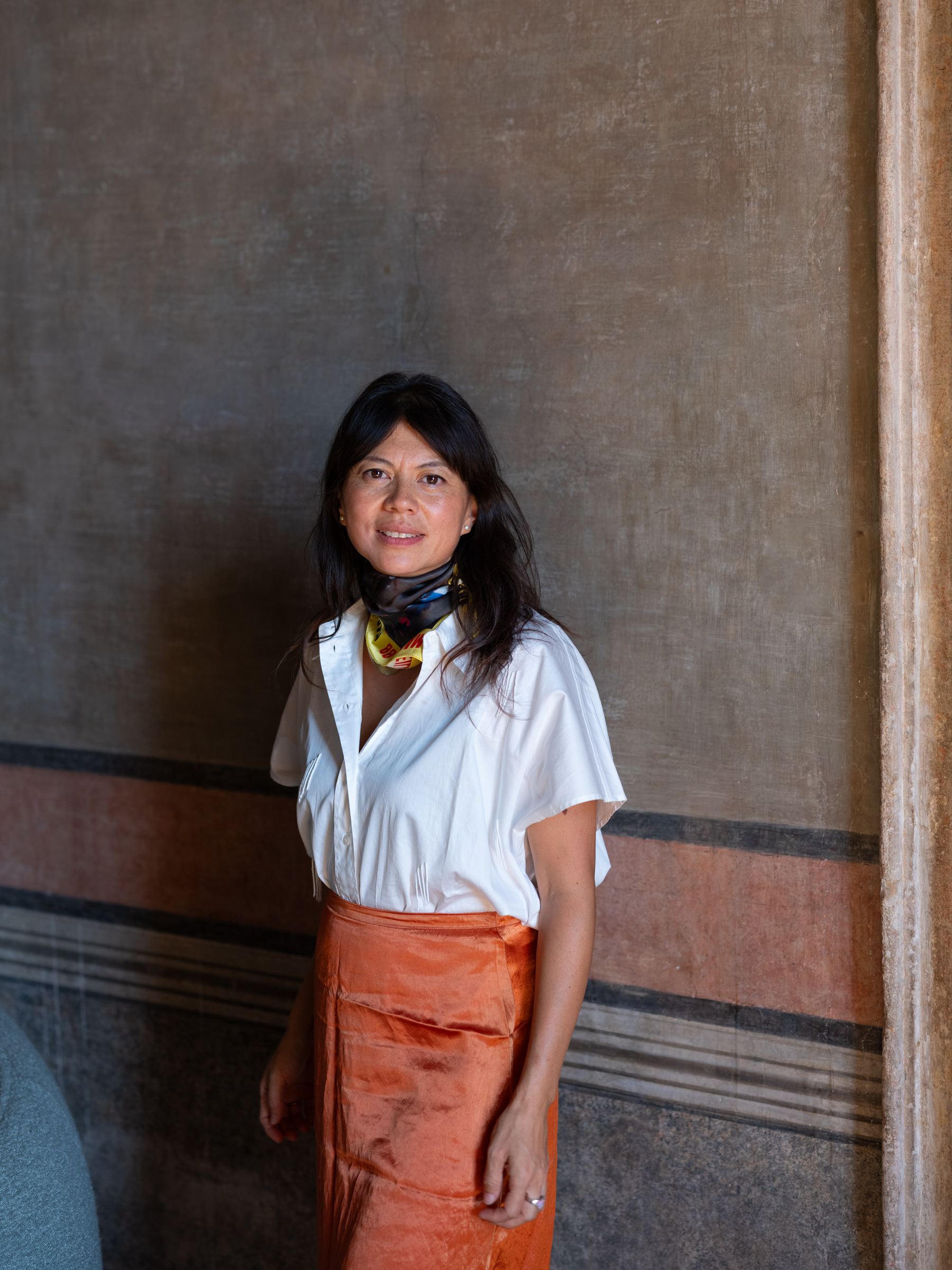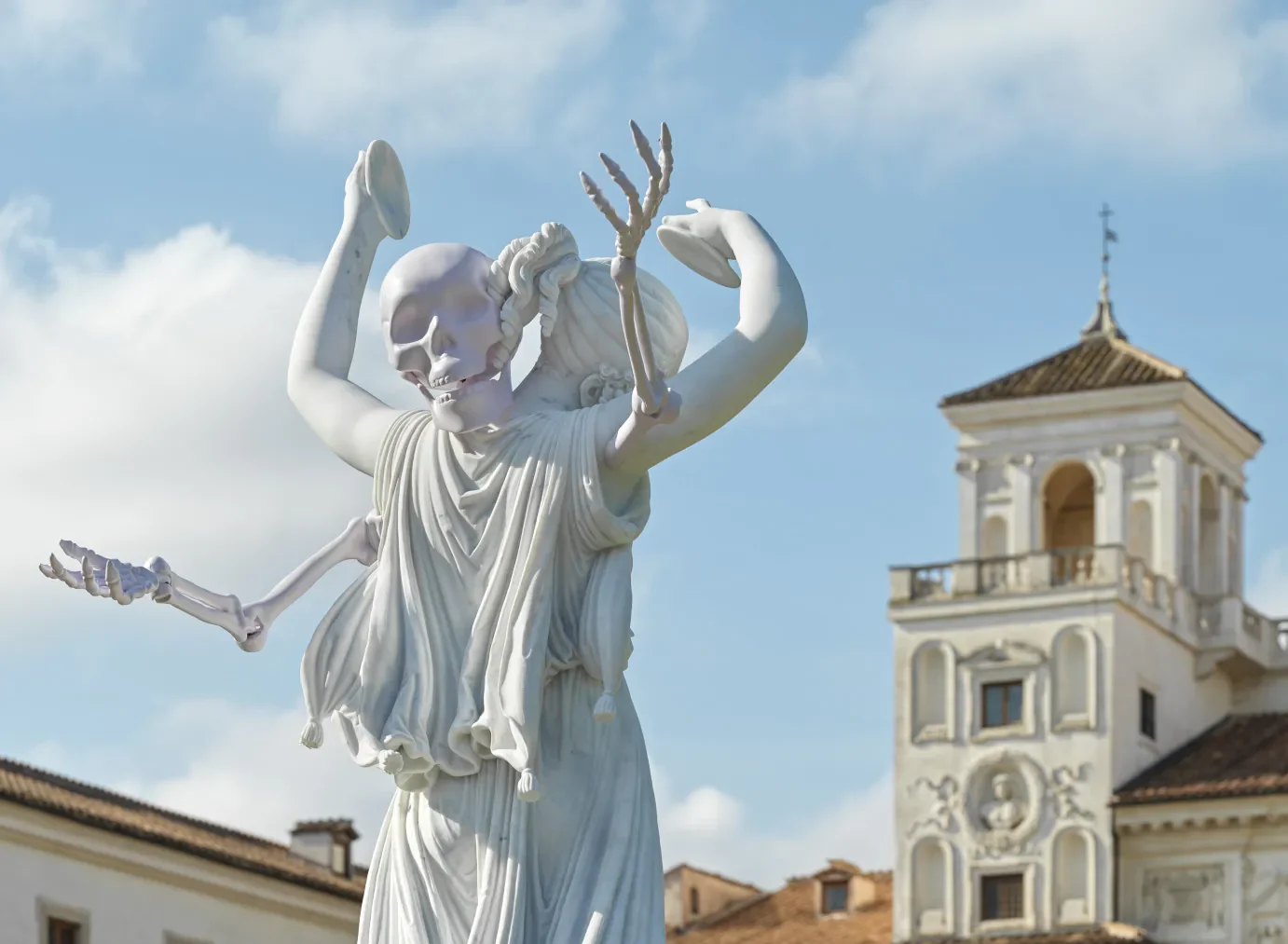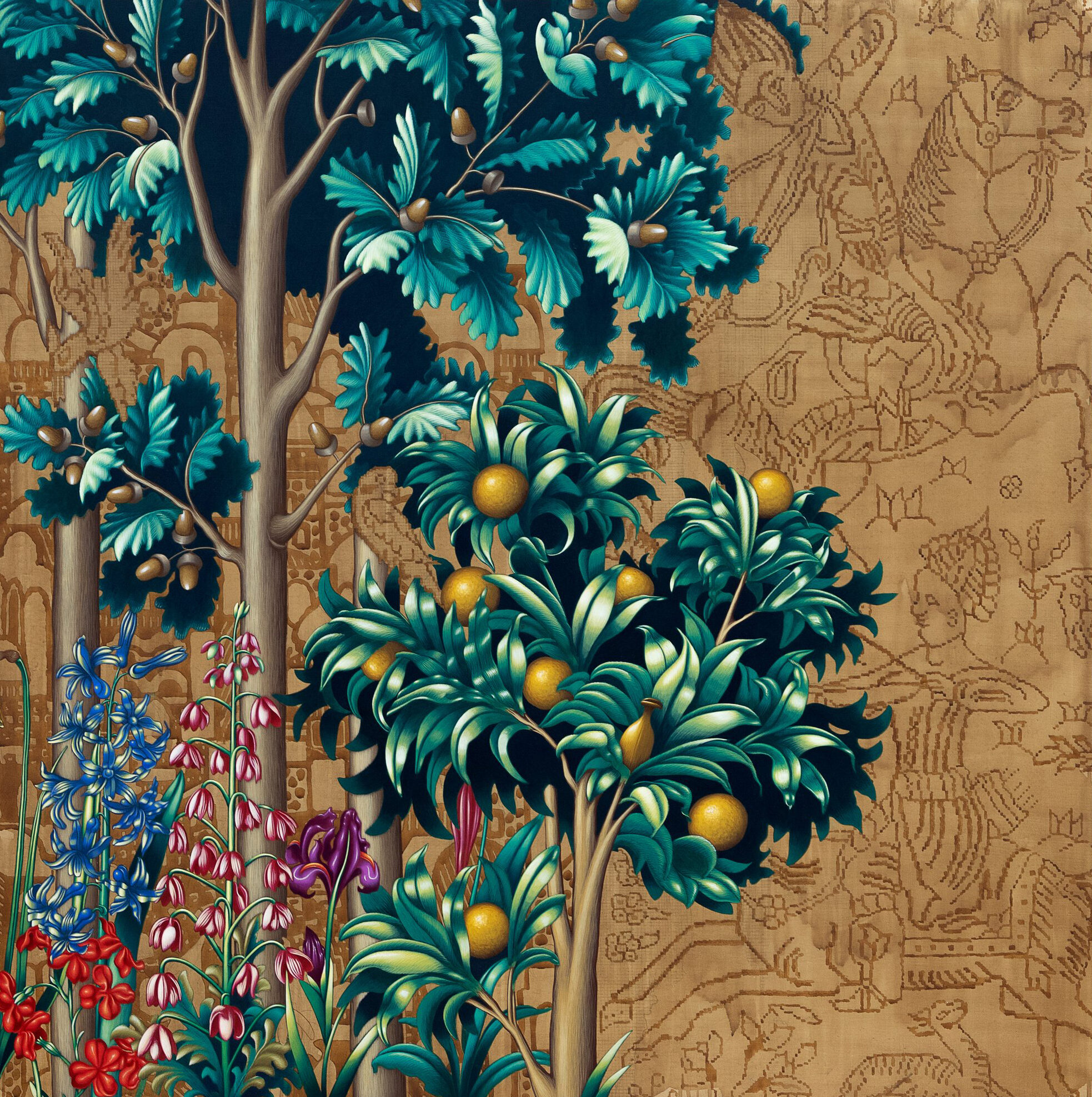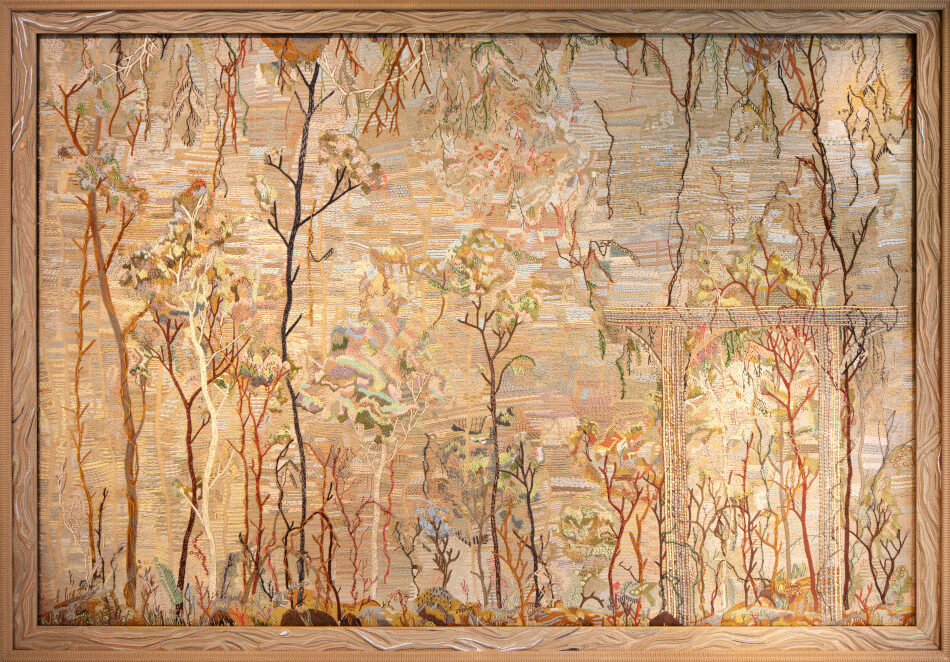Search
White Night
27.11.2025
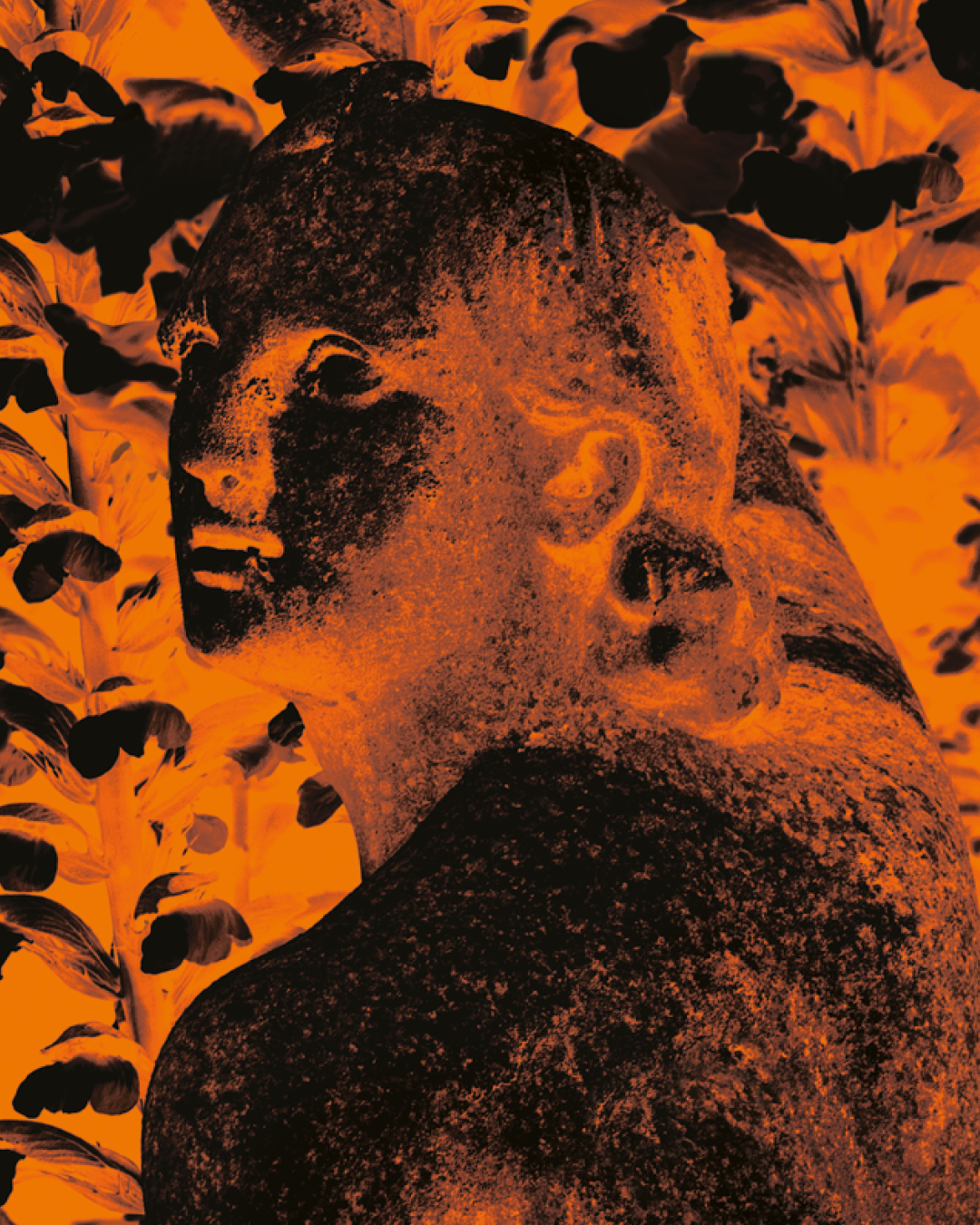
- Residents and guest artists
- Bayan Abu Nahla
- Mahmoud Alhaj
- Trio Aura
- Claude Baechtold
- Rob Bridger
- Martin Flugelman
- Alice Héron
- Karim Kattan
- Husam Maarouf
- Florent Marcozzi-Moati
- Milad Mohammadi
- Niloufar Mohseni
- Federico Placidi
- Some Strings
- Adriano Tramontozzi
- Alice Visentin
- Hani Zurob
White Night, a nocturnal festival of contemporary creativity, returns to Villa Medici on Thursday, November 27 to showcase the work of the sixteen fellows in residence at the French Academy in Rome, as well as the residents and invited artists. For one evening, White Night invites visitors to immerse themselves in the vitality of current creation with a program that celebrates the plurality of art forms, including performances, readings, concerts, installations, and screenings.
On this occasion, the fellows, residents, and invited artists will share their creative work and research with the public in the fields of music, visual arts, history and theory of the arts, literature, architecture, and culinary practices.
The White Night is designed as a free stroll through the building and the historic gardens of Villa Medici. In the darkness of the garden, round a bend in a path or behind a door in the palace, visitors are invited to encounter the works that have inhabited the premises for centuries or for one night, in a spirit of dialogue between venerable heritage and contemporary creation.
In these troubled times, the fellows want the White Night to be a moment of sharing and solidarity. Collectively, they declare:
Black night
A White Night is a night without sleep.
Spent partying, or trying to survive under the fire of bombs.
We’d like to dedicate this night to our fellow artists who are creating and resisting, from spaces under siege, looted and destroyed; from displacement or exile.
As artists and writers, we are constantly questioning the meaning of artistic endeavors in a world ravaged by oppression. But we must continue to create an archive, a counter-narrative, and surround ourselves with the voices of the lost and the presence of the living. And to be able to hear, see and welcome these voices, we need to be silent and let the night finally be dark.
Installations
Continuous all evening
"Concretum fit vastum", Alia Bengana
Alia Bengana is an architect and researcher specializing in sustainable materials.
She questions contemporary industrialized construction systems and advocates sober, repairable methods based on local resources, to build without producing tomorrow’s waste. Her work is also inspired by ancient techniques, where architecture knew how to last, transform or return to the earth.For the White Night, Alia Bengana presents a video installation. For a century, reinforced concrete has embodied progress and modernity, but in just a few decades it has degraded, cracked and collapsed. As the first building material destined to become waste, it leaves only unusable ruins.
Concretum fit vastum
2025
Video installationIn collaboration with: Claude Baechtold
"Il mare non ha volto", Giulia Lorusso
The installation is accompanied by two performances at 9pm and 10pm with Giulia Lorusso, Farnaz Modarresifar and Federico Placidi (20′).
Multimedia composer, Giulia Lorusso combines sound installation, musical theater and video in a collaborative, participatory approach. In Rome, she created Cercle, a work for choir, electronics and video inspired by the myth of Circe. Organized into two tableaux – immersive meditation and collective experience – it examines the quest for identity and metamorphosis.
For the White Night, Giulia Lorusso presents an installation combining music and video around the sea. For the composer, the sea is the starting point of her research: it is multiple, belly, memory, border, exile, promise and memory – it is a body without a name, between threat and necessity, a point of departure as well as a land of welcome.
Il mare non ha volto
2025
InstallationAudio: Giulia Lorusso
Video: Giulia Lorusso Giulia LorussoFlorent Marcozzi-Moati
With the participation of Farnaz Modarresifar and Federico Placidi"Mauve, Jim and John", Paul Maheke and Rob Bridger
Visual artist, Paul Maheke works between painting, drawing, installation and performance to question marginalized narratives. His project Les ombres des gisant-e-s se tiennent debout looks at funeral practices and post-mortem marginalization, mixing ancient and contemporary history to depict invisible presences, between oblivion and commemoration, violence and reparation, visibility and invisibility.
For the White Night, Paul Maheke presents Mauve, Jim and John, a film made in collaboration with dancer and choreographer Rob Bridger, based on the trajectory of a UFO sighted in Suffolk in the 1980s. This story is reinterpreted by the two artists, who reinvent its observation in a choreography of desire and dependence.
Mauve, Jim and John
2021
Film (28’05)Film: Paul Maheke, Rob Bridger
Shooting and editing: Tilly Shiner, Paul Maheke
Cameraman: Simon Eaves
Sound recording and composition: Gus Collins, House of Noise
Commissioned and produced by Artangel with The National Trust, UK"Opera aux vivants & non vivants", Marie-Claire Messouma Manlanbien
Visual artist, Marie-Claire Messouma Manlanbien combines sculpture, textiles, installation and performance, drawing on African traditions and ecofeminist issues. At Villa Medici, she designed a tapestry with balsamic virtues, inspired by ancient Italian models, combining crafts and pharmacopoeia to create an art-care object linking memory, body and territory.
For the White Night, the artist presents an in situ installation, a cartography of ceramics and plants, around the Loggia de Cléopâtre at Villa Medici. In her works, Marie-Claire Messouma Manlanbien blends media, techniques and materials to create ecosystems of poetic, ephemeral narratives. She is interested in the complex relationships between notions of universal popular culture, everyday life and traditional craft processes.
Opera aux vivants & non vivants
2025
Ceramics, plants"Una distanza senza rive", Enrique Ramírez
Multimedia artist, Enrique Ramírez uses video, sound and installation to explore the sea as a space of memory, narratives and passage, where individual and collective memory intertwine. At Villa Médicis, her Ánan project is based on the study of a Yagán canoe preserved in Rome, the starting point for a reflection on migration, transmission and memory. The sea becomes a space of drift, loss and orientation, in search of a new common course.
For the White Night, Enrique Ramírez presents Una distanza senza rive, an installation that takes as its starting point the phrase “Tra gli sradicati una lacerazione: un fiume, un oceano, una distanza senza rive“. Installed at Villa Medici, far from the water but inhabited by its memory, the work transforms the river’s absence into a space for poetry and reflection. Here, water becomes a metaphor for displacement and uprooting, an imaginary place where the voices of exiles merge with the breath of wind and light. Ramírez weaves a silent poem about distance, identity and fragility.
Una distanza senza rive
2025
Neon installationProduction: Veronafiere S.p.A. for 20th edition ArtVerona
The project was conceived by Laura Lamonea and curated by Pascale Cassagnau."À voix haute"
For the White Night, the fellows of Villa Médicis honor the voices, words and presence of poets from Gaza and, more broadly, from Palestine. For the duration of the White Night, the Neviera, a private space at Villa Medici, opens to the public to let their words resound – and with them, those of the residents – as a gesture of solidarity with the Palestinian cause.
Sound installation
Sound recordings featuring the voices of Alia Bengana, Diaty Diallo, Marin Fouqué, Elitza Gueorguieva, Camille Lévy Sarfati, Giulia LorussoFlorent Marcozzi-Moati, Randa Maroufi
Texts
- I am you and Let it become a story, Refaat Alareer;
- To those who inherit the worst, Diaty Diallo;
- Promise, Shorouq Mohammed Doghmosh;
- Genocide, Nuit and Pousser droit, Marin Fouqué;
- Tales of the storyteller, Fatina al-Ghorra;
- Being a mother in Gaza, Neeamat Hassan;
- The old stones, Walid al-Halis;
- Zahrat al-Mada’en (Faïrouz’s Song), Assi Rahbani, Mansour Rahbani ;
- Who we areMona al Msaddar
- A star said yesterday and another quoted Hiba Abu Nada;
- Rubbama, Samih al-Qasim (“I will resist”, French translation by Abdellatif Laabi);
- Words of Abu Enad (Beit Lahia), Gaza, from the film Gaza-strophe by Samir Abdallah and Khéridine Mabrouk (2009).
"Another Earth", Ben Russell
Artist, filmmaker and curator, the work of Ben Russell experimental cinema, visual anthropology and documentary, in which he blends contemporary mythologies and forms of perceptual resistance. In Rome, he directed The Smiling Ghost, a film/installation following a ghost as he wanders through Rome’s ancient ruins, urban wastelands and squats. Questioning the survival of these places, the work invites the present to replay the past, and the ruins become sites of a living memory, contested and potentially re-enchanted.
For the White Night, Ben Russel presents Another Earth, a dizzying 16mm portrait of an increasingly chaotic present, whose political contours are affected by everything and nothing at once. The film is a plunge into a psychedelic universe of strata of subterranean and real visions, accompanied by the frenetic repetition of the phrase “Time is not what it is, but what it feels like.”
Another Earth
2025
Film, 16mm (10’40)"Nuit noire", Bayan Abu Nahla, Mahmoud Alhaj, Hani Zurob
Bayan Abu Nahla, Mahmoud Alhaj, Hani Zurob
“What does night mean in times of genocide? What does light carry – from flares, from torture cells, from the devastating fires of Israeli forces? Against destruction, Palestine resists, and with it, for it, in it, a multitude of artists.
Nuit noire is an invitation to three of them: Bayan Abu Nahla, Mahmoud Alhaj and Hani Zurob. All three have been living, creating, producing form and thought since the Catastrophe. In Gaza, then in exile, their work is a trace, a narrative, an archive – a resistance to erasure.” Camille Lévy Sarfati
Nuit noire
ExhibitionWith Bayan Abu Nahla, Mahmoud Alhaj, Hani Zurob
An invitation by Camille Lévy Sarfati, Randa Maroufi, Diaty Diallo, Marin Fouqué, Thu Van Tran
In collaboration with Ma’an for Gaza artists collective"Les Couleurs du Gris", Thu Van Tran
Thu Van Tran is a visual artist whose work explores notions of contamination, identity and memory, inspired by literature and colonial history.
For the White Night, Thu Van Tran presents a new set of paintings from her Les couleurs du gris series. Made from collected minerals and heavy metals, these works extend a reflection on conflict-scarred soils and the memory inscribed in them. The artist speaks of ecocide – the destruction of natural environments that accompanies domination and the violence of war. After examining the history of Vietnam and the persistent toxins that have left their mark on the land, here she uses color to evoke the Palestinian territory as a wounded space, where the earth forever bears the trace of destruction.
Gray is born of the chromatic duel between red and green – complementary colors that cancel each other out – enriched by dramatic black and evanescent white. Red, green, black, white: a palette designed to echo the colors of the Palestinian flag, where smoke, melancholy and the persistence of light respond to each other. Presented like windows opening onto a suspended landscape, the canvases are balanced on lemons, the solar symbol of the Mediterranean. In counterpoint, their vibrant yellow recalls the vitality of a land and a light that are now being erased.
Les Couleurs du Gris
2025
195 x 135 cm per painting
Linen, plaster, limestone, lime, cadmium red, cinnabar red, mars red, Verona earth, phthalocyanine green, cobalt green, green earth, malachite green, nickel green, ivory black, mars black, titanium white, lime white, zinc white"Sans titre", Alice Héron
Chef and interdisciplinary artist, Alice Héron explores the links between food, gesture and imagination. She creates performative meals and installations where cuisine, design and sculpture meet. Her work questions the act of eating as a sensitive experience, combining matter, relationship and memory. She is currently in residence at Villa Medici as part of the culinary practices program.
For the White Night, Alice Héron presents an installation, a clay landscape inviting the public to break certain shapes containing cooked fruit and vegetables. This gesture, somewhere between excavation and fracture, confronts the destruction of a territory while revealing the vital link between food and earth.
Sans titre
2025
Clay, cooked fruit and vegetables"Ici ces drapeaux n'ont pas pu exister."
A collective work born of urgency, Ici ces drapeaux n’ont pas pu exister, is a response to constraint, a disturbance, a parasite. Playing on the accumulation of colors and shapes, the symbols of ongoing struggles gradually appear in strata, paving the façade of the institution. Intertwined and interconnected, they invite our gaze to consider them as much for their enforced disappearance as for their power of unstoppable resistance. Operating like a bug in the White Night – an intranquillity of the dark night – they pay homage to those who persist, who rise up, who slip between the cracks.
Ici ces drapeaux n’ont pas pu exister.
Glitched video projection
2025A collaboration of Alia Bengana, Arianna Brunori, Diaty Diallo, Marin Fouqué, Elitza Gueorguieva, Alice Héron, Camille Lévy Sarfati, Hugo Lindenberg, Giulia Lorusso, Paul Maheke, Marie-Claire Manlanbien, Randa Maroufi, Baptiste Pinteaux, Enrique Ramírez, Ben Russell, Thu Van Tran
Performances, Meetings, Concerts, Cinema
| ○ | Performances preceded by this symbol require a separate reservation (free of charge) due to limited seating. |
5:15pm ○ Meeting "Nuit Noire"
MEETING, 75′ (Grand Salon)
In Arabic, with English translation
Reservations required (link coming soon)With Bayan Abu Nahla, Mahmoud Alhaj, Hani Zurob
An invitation by Camille Lévy Sarfati, Randa Maroufi, Diaty Diallo, Marin Fouqué, Thu Van Tran“What does night mean in times of genocide? What does light carry – from flares, from torture cells, from the devastating fires of Israeli forces? Against destruction, Palestine resists, and with it, for it, in it, a multitude of artists.
Nuit noire is an invitation to three of them: Bayan Abu Nahla, Mahmoud Alhaj and Hani Zurob. All three have been living, creating, producing form and thought since the Catastrophe. In Gaza, then in exile, their work is a trace, a narrative, an archive – a resistance to erasure.” Camille Lévy Sarfati
Translation: Jalal Qafisha
In collaboration with the Ma’an for Gaza artists collective6pm - 8pm Mediation "Les Niobides"
MÉDIATION (Carré des Niobides)
The Niobides group, a replica of the 1st- and 2nd-century originals housed at the Uffizi in Florence, recounts the myth of Niobe, Queen of Thebes, who dared to boast that she had given birth to more children than Leto, mother of Artemis and Apollo. To avenge the affront to their mother, the brother and sister pierce Niobe’s unfortunate offspring with their arrows. Balthus not only decided to copy the group, but also designed its layout in a square of the gardens, with a scenography combining artificial rocks, vegetation and water jets. The aim of the recently-completed worksite was to restore these sculptures made of cement or resin. It was also an opportunity to learn more about the creative process of Michel Bourbon, the sculptor who created them.
6:30 pm – 11:30 pm Video program
VIDEO PROGRAM (Salle cinéma Michel Piccoli)
Without reservation, subject to availabilityFor the White Night, the fellows of Villa Medici invite Some Strings, an initiative that brings together over seven hours of films shown in theaters, festivals, streets and camps.
Video programPalestinian poet and teacher Refaat Alareer was killed by Israeli air strikes in northern Gaza, along with seven members of his family, on December 6, 2023. In his last poem, If I Must Die, published five weeks before his assassination, Refaat Alareer called on those who would remain alive to build a kite – a historic symbol of resistance – from pieces of string, or “some strings”.
Just as Refaat Alareer readers were invited to participate in this symbolic act, over a hundred artists and filmmakers from around the world contributed small filmic gestures that make up Some Strings, to carry its message further – offering a diversity of impressions, ideas, feelings, perspectives and testimonies about one of the darkest moments of the 21st century.Some Strings
2024–present
Various artists
304 min 30 s7:30 pm ○ Persian music
CONCERT, 30′ (Grand Salon)
Reservations required (link coming soon)Trio AURA
Farnaz ModarresifarMilad Mohammadi, Niloufar MohseniComposer, poet and santurist Farnaz Modarresifar integrates traditional Persian music into a language that is both lyrical and contemporary. During her residency, she composed an orchestral and choral work in dialogue with Igor Stravinsky’s opera Œdipus Rex, drawing on the myth and its symbolism to inscribe collective notions of exile, fatality and spiritual quest, echoing her own journey marked by crossing, memory and resistance.
For the White Night, the concert with Trio Aura presents a program of improvisation reinterpreting the classical Persian repertoire, exploring new forms of expression, mixing free improvisations, daring rearrangements and original compositions. The ensemble, founded by three musicians of Iranian origin united by a deep passion for Persian classical music and a shared vision of its interpretation, is actively contributing to the revival of contemporary Persian music.
Santûr: Farnaz Modarresifar
Târ: Milad Mohammadi
Tombak: Niloufar Mohseni8:30 pm ○ Reading "Tous ces jardins dans nos prénoms"
READING, 25′ (Grand salon)
In French, translation of the texts in Italian (leaflet distributed)
Reservations required (link coming soon)Elitza Gueorguieva, Karim Kattan
Writer, performer and documentary filmmaker Elitza Gueorguieva uses tragi-comedy to question identity and heteronormativity. At the Villa Medici, she wrote a novel inspired by her naturalization procedure, fed by archives from 1939, around the notion of the “useful woman”, between satire and memory, mixing individual destiny and collective echoes.
For the White Night, Elitza Gueorguieva invites Palestinian writer Karim Kattan for a reading in two voices. A city in the sky, a strange east wind, a frog in front of a prefecture in France, intersecting glances: the artists invite us on a journey between cities, passages and voices.
Texts: Hiba Abu Nada, Elitza Gueorguieva, Karim Kattan
Music: Giulia Lorusso9 pm ○ "Alchimia quotidiana" performance
PERFORMANCE, 20′ (Petit salon)
Reservations required (link coming soon)Arianna Brunori, Farnaz Modarresifar, Alice Visentin
Art historian and writer Arianna Brunori studies the links between alchemy and the visual arts between the late Middle Ages and early Modernism. In residence, she is writing a book on these philosophical and artistic relationships, exploring the boundary between generation and imitation in the Renaissance.
For the White Night, Arianna Brunori invites artist and researcher Alice Visentin and composer and musician Farnaz Modarresifar for a performance combining reading, projection and music around the theme of alchemy. Today, alchemy might seem eccentric and dusty, like some old wedding dress. However, on closer inspection, this discipline conceals some luminous insights: from the perception of the unity of the natural world to the idea of a necessary relationship between technique and contemplation. The performance Alchimia quotidina is thus in keeping with this tradition, to find the keys not to an alleged mystery, but to our profane everyday life.
Texts: Arianna Brunori
Video and installation: Alice Visentin
Santûr: Farnaz Modarresifar9 pm Performance "Il mare non ha volto"
PERFORMANCE, 20′ (Loggia Balthus)
Without reservation, subject to availability (also at 10 pm)Giulia Lorusso, Federico Placidi
A multimedia composer, Giulia Lorusso combines sound installation, musical theater and video in a collaborative, participatory approach. In Rome, she created Cercle, a work for choir, percussion, electronics and video inspired by the myth of Circe. Organized into two tableaux – immersive meditation and collective experience – it examines the quest for identity and metamorphosis.
For the White Night, Giulia Lorusso presents an installation combining music, voice and video around the sea. For the composer, the sea is the starting point of her research: it is multiple, belly, memory, border, exile, promise and memory – it is a body without a name, between threat and necessity, a point of departure as well as a land of welcome.
Piano and electronics: Giulia Lorusso
Double bass-cello and electronics: Federico Placidi9:30 pm ○ Performed reading "Les âmes vivantes" (Living souls)
PERFORMED READING, 30′ (Grand salon)
Reservations required (link coming soon)In French, a leaflet with translations of the Italian texts will be distributed.
Author and performer Diaty Diallo works on the bodies of racialized people, care and reparation. At Villa Medici, she is conducting a literary and biographical investigation into sexual disorders, crossing trauma, heritage and the impossibilities of métissage, to write a poetic fiction to be told and read, weaving together somatic memory and the sensuality of language.
For the White Night, Diaty Diallo offers a performance reading of a text inspired by the residents of the Fauvettes district. The end of the Grandes Aigrettes district is approaching: abandoned by the public authorities, the housing estate is emptying out, and its residents are being forced to leave as time goes by.
Reading performance on a loop of winds and ghosts’ song
Text and music: Diaty Diallo
Text published at the invitation of Alexia Fiasco and Claire Lapeyre Mazérat of the Maestra association; published in issue 11 of La Déferlante magazine in 202310:30 pm ○ Performed reading "Dying safely - نموت بأمان"
PERFORMED READING, 30′ (Grand salon)
In French, translations in Italian and Arabic distributed or projected
Reservations required (link coming soon)Marin FouquéHusam Maarouf, Adriano Tramontozzi
Novelist, poet and performer, Marin Fouqué’s work explores the notion of virility and its various mechanisms of body training. This year, as a resident at Villa Medici, he is developing a novel around the many myths of masculinity, from the Italian film character Maciste to contemporary masculinist influencers, using the body and writing to find possible points of escape from our relationships of domination.
Husam Maarouf is a poet and novelist. Co-founder of Gaza Publications, he is himself the author of a novel and two collections of poetry, including *Death Has a Smell of Glass*, which was awarded the Mahmoud Darwish Museum Prize in 2015. He also writes about literature for various Arab newspapers and publications. Born in Palestine, he still lives in Gaza.
For the White Night, the two authors present together and despite the distance Dying safely – نموت بأمان, an original two-voice performance. In the figurative space of a ring and accompanied by Roman boxer Adriano Tramontozzi, they offer us to experience and hear an ongoing reflection on notions of virility and violence, on the profound differences that exist between boxing and war, and on what violence and horror can produce once forcibly lodged in our bodies. “Impressions of fights mingle with poems about the genocide and colonization perpetrated by the State of Israel in Palestine. As if in a boxing ring, words look at each other, respond to each other – and sometimes collide.
Performed reading for punching bag, voice and body
Texts: Marin Fouqué, Husam Maarouf
Performance: Marin Fouqué, Adriano Tramontozzi10 pm Performance "Il mare non ha volto"
PERFORMANCE, 20′ (Loggia Balthus)
No reservation necessary, subject to availability (also at 9pm)Giulia Lorusso, Farnaz Modarresifar, Federico Placidi
A multimedia composer, Giulia Lorusso combines sound installation, musical theater and video in a collaborative, participatory approach. In Rome, she created Cercle, a work for choir, percussion, electronics and video inspired by the myth of Circe. Organized into two tableaux – immersive meditation and collective experience – it examines the quest for identity and metamorphosis.
For the White Night, Giulia Lorusso presents an installation combining music, voice and video around the sea. For the composer, the sea is the starting point of her research: it is multiple, belly, memory, border, exile, promise and memory – it is a body without a name, between threat and necessity, a point of departure as well as a land of welcome.
Piano and electronics: Giulia Lorusso
Double bass-cello and electronics: Federico Placidi
Santûr: Farnaz Modarresifar
Practical information
Thursday, November 27, 6 pm to midnight (last entry at 11:30 pm)
Reservations:
Admission to the White Night is free with reservation (online).
Your ticket will be required at the entrance.
Some performances require a separate reservation (free of charge) due to limited seating.
Opening of reservations for the relevant performances: Tuesday, November 25.
On the occasion of the White Night, Eva Jospin’s installation at Villa Medici will be accessible free of charge.
Good to know:
- The historic garden of Villa Medici is a non-smoking area. Please respect it by using the smoking area and by sorting your waste in the dedicated garbage cans.
- Food and drinks for sale in the gardens throughout the evening.
- Villa Medici has no on-site checkroom.
- Motorcycle helmets, suitcases, bulky or dangerous objects are not allowed on Villa Medici premises, nor are pets, with the exception of guide dogs.
- It is possible to attend the White Night with a small bag.
Thank you for your understanding.
